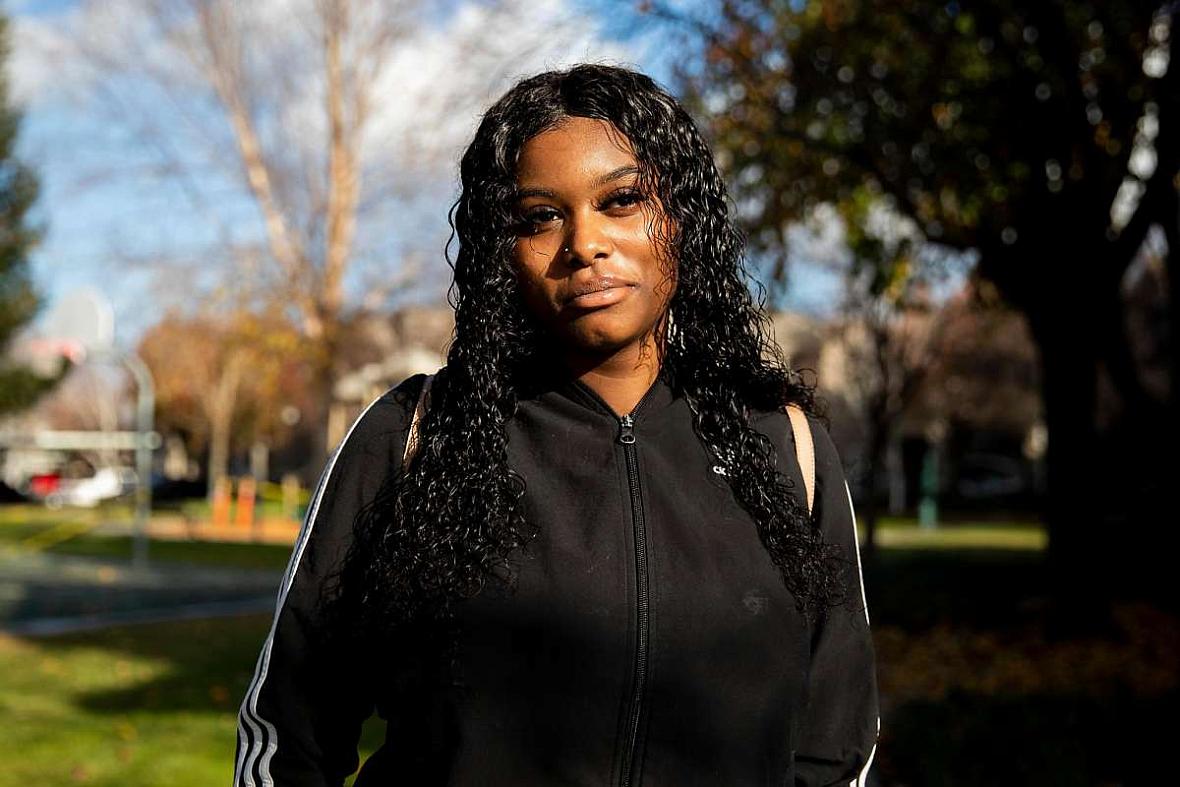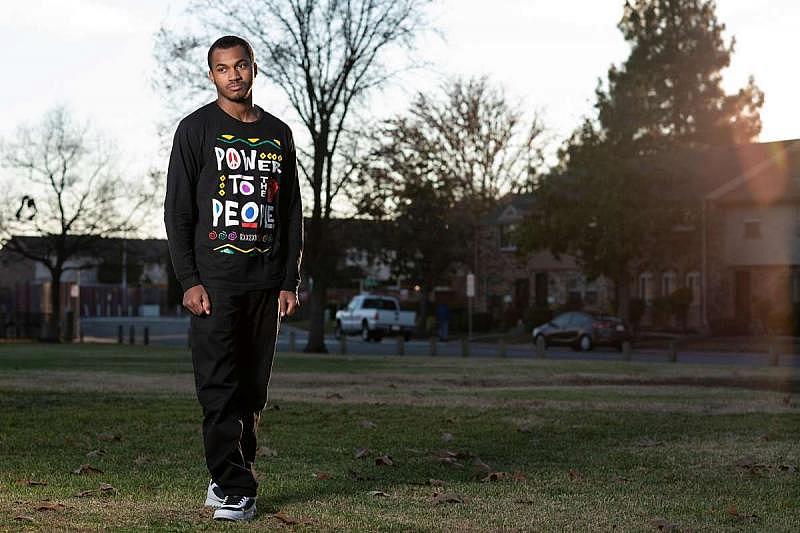Confronted over abuse, California is bringing 116 kids home from faraway programs. Counties are scrambling
This story is part of a larger project by The San Francisco Chronicle and The Imprint. Reporter Cynthia Dizikes was a participant in the 2019 Data Fellowship, a program of the Center for Health Journalism at the University of Southern California’s Annenberg School for Communication and Journalism.
Other stories in this series include:
Amid abuse reports, Sequel-run facility that treated California children will close
After abuse probe, another Sequel-run program that housed California youth will close

Maxwell, shown near her Stockton home, says staff at out-of-state facilities where she was sent abused children in their care.
Jessica Christian / The Chronicle
County officials across California are scrambling to find new homes for more than 100 children with mental health and behavioral issues, following the state’s landmark decision to stop shipping these young people to faraway facilities.
The state’s abrupt shift came in response to an investigation by The Chronicle and The Imprint, which detailed allegations of violent abuse at institutions certified by California. Reporters found that the state’s Department of Social Services knew for years that children at out-of-state treatment programs run by a for-profit company, Sequel Youth & Family Services, had accused staff of choking, punching and sexually assaulting them.
After reviewing some of the same records compiled by reporters, the social services agency this month declared the programs “lacking,” ordering 116 boys and girls currently placed out of state to be returned to California within 45 days. Youth advocates, who have long decried these distant placements, cheered the decision.
But local probation and child welfare officials were left reeling. They said that while they understood the need to cut ties with the programs, the state should have informed them of widespread problems sooner.
Without adequate support from the state, these officials said they fear foster children and teens adjudicated for crimes could end up languishing in juvenile hall cells, hotel rooms or other places ill-equipped to handle their mental health needs.
“To receive the news last week in this way puts us in a very difficult position,” said San Francisco Juvenile Probation Chief Katy Miller, whose department has two youth in out-of-state programs.
“But as difficult as it is, I’m hopeful that it will lead to options for kids in California that meet their needs,” Miller said. “It lends urgency to the situation that we haven’t previously seen.”
Since 2015, California judges have sent thousands of children to out-of-state programs to receive treatment for mental health and behavioral issues. Many of these young people were removed from abusive and unsafe homes, charged with crimes and — in some cases — sexually trafficked.
About half of the state’s boys and girls went to facilities operated by Sequel, a $450 million company whose programs have faced scores of violent abuse allegations. In May, a Michigan teen died after staff members at one of these Sequel-run programs piled on top of him for throwing pieces of bread in the cafeteria.
The Chronicle and Imprint investigation found that California relied on Sequel facilities despite a state law that forbids the use of for-profit residential programs, an effort to ensure treatment is prioritized over financial gain.
Though the treatment centers used by California are legally organized as nonprofits independent of Sequel, they send a combined 83% of their revenue back to Sequel to “manage and operate” the campuses. California officials defended the use of the programs, saying it is common for a for-profit company to “establish and support” nonprofits.
The facilities, which house from dozens to hundreds of children at a time, are in Florida, Iowa, Nevada, Pennsylvania, Utah, Virginia and Wyoming.
The decision to sever ties with these programs came as a surprise to child welfare directors, who were frustrated to receive so little notice ahead of the announcement, said Cathy Senderling-McDonald, deputy executive director of the County Welfare Directors Association of California.
“We expect the licensing agency to collect and review incident reports on an ongoing basis and address issues as they arise, not just in one blanket decision to decertify all of the homes,” Senderling-McDonald said. “I never would have expected that.”
Staff members intimidated and demeaned residents, failed to get children prompt medical attention and used “excessive force” during hands-on restraints that caused bruises or injuries, according to the letters. Additionally, state officials wrote, employees in some programs failed to provide children with enough food and water, and prohibited residents from using the bathroom, speaking to peers of the opposite sex and attending religious services.
Sequel representatives told The Chronicle and The Imprint that they take allegations of abuse seriously. In a statement, they said their facilities have increased staff training and oversight and are phasing out the practice of physically restraining children.
Youth advocates had for years pushed California to stop using out-of-state treatment programs, citing dangerous and isolating conditions that can further harm vulnerable young people who have already endured significant trauma.
Concern was so great that Youth Law Center, a national organization based in San Francisco, threatened to sue California this summer over its use of out-of-state treatment programs, Executive Director Jennifer Rodriguez said.
“These facilities are inherently dangerous, and neither the state nor counties are able to monitor them adequately,” she said. “How many youth have to lose their lives and well-being before we learn our lesson?”
Rodriguez said she is relieved that young people from California will be kept out of faraway facilities, but worries the shift could be temporary. While California is cutting ties with its current slate of programs, it has not banned the practice of sending children out of state, leaving open the possibility that it could reapprove facilities later.
In an email to The Chronicle and The Imprint, California officials said they would review future applications from out-of-state providers to ensure the facilities meet state licensing requirements, though none is pending. Programs also can appeal to have their certification reinstated; state officials said one program has already asked California to reconsider, but did not specify which program.
In the meantime, California officials said they have offered counties support as they transition away from distant treatment programs, including assistance finding foster families and other placement options.
California has been reducing its reliance on residential treatment programs in recent years, as part of an overhaul of its foster care system. Despite last week’s decision, child welfare and probation departments have had years to find alternatives to residential centers, youth advocates said.
Local probation and child welfare officials, however, fear the sudden change could create delays in treating children with complex needs, especially if new programs aren’t quickly propped up with additional state funding.
Many of the children whom California sends out of state have challenged previous caregivers by running away or getting kicked out of residential programs. Some have no family members to take them in.
“One hundred and sixteen people doesn't sound like that many, but there’s a reason they were out of state,” Senderling-McDonald said. “We weren't able to find services here, or placement providers rejected them over and over again.”
As of last week, San Joaquin County had six youth in out-of-state treatment programs, said Akkia Pride-Polk, deputy director of Children’s Services. Pride-Polk said the young people may end up in the Mary Graham Children’s Shelter in French Camp, just south of Stockton, while the county tries to find them more permanent homes or programs.
The shelter for foster youth was the subject of a 2017 Chronicle investigation that found its staff relied heavily on police to handle children’s minor emotional outbursts, with the arrests far surpassing other shelters in the state. The shelter’s director said at the time that his employees called law enforcement only when they were dealing with an emergency.
“I would really love for the public to be aware that there is a need for foster families to take in these youth,” Pride-Polk said.
Teens adjudicated for crimes can spend months in juvenile hall waiting for probation officers to find beds for them in treatment facilities — a period of limbo referred to as “dead time” because it delays their ability to complete the court-ordered program and go home. Officials fear those waits could stretch longer now that out-of-state programs are not an option.
Some of these youth could go to foster homes, but, “It’s just so hard to get people in the community willing to take kids who have these charges on their record,” said Maura Rogers, a supervising deputy public defender in Riverside County. Rogers’ office is representing several of the young people who will return to California in the weeks ahead.
Former residents, too, worried that the hasty move could hurt kids struggling to find stability.
“They may be eliminating one problem,” said Josiah, a 19-year-old who was sent to Lakeside Academy from Sacramento’s juvenile hall in 2018. “But if they don’t do this right, they could be creating even more.”
Josiah, 19, at Phoenix Green Park in Sacramento, spent one year at Lakeside Academy in Kalamazoo, Mich., where a teen died after Sequel staff piled on him. Salgu Wissmath / Special to The Chronicle
Some probation departments have already ended out-of-state placements without facing major setbacks.
The Alameda County Probation Department stopped the practice this year. The Sacramento County Probation Department, which oversaw 52 out-of-state placements in 2019, stopped using treatment programs outside California in May, shortly after Cornelius Fredericks’ death at Lakeside Academy.
Sacramento officials have been able to find community-based services, in-state programs and foster families to fill the need, said Marlon Yarber, the county’s assistant chief probation officer.
“I can’t look a parent in the eye and say, ‘I’ve taken care of your son or daughter,’ if I’m putting him or her in a place where I know there’s abuse alleged to have happened,” Yarber said. “The very unfortunate death in Michigan brought a lot of things to light that needed to be fixed. We’ve got to be better. We’ve got to figure out better options.”
For youth advocates and former residents, the public recognition of persistent problems has been a long time coming.
Maxwell, identified by her last name to protect her confidential child welfare record, was 9 years old when she ended up in foster care after her mother was killed. Working through her trauma and the resulting behavioral issues, Maxwell was later sent out of California to two programs in Utah.
When Maxwell complained about staff being aggressive at the first facility, she said, she was moved in September 2017 to an even worse program: Red Rock Canyon School, run by Sequel.
Instead of helping youth, she said, staff members at Red Rock punched and choked them, leaving them with black eyes and bruises. Utah shuttered Red Rock Canyon in 2019 after staff members were charged with child abuse for allegedly hitting and sexually assaulting residents.
Sequel officials have declined to comment on individual allegations of abuse, as well as the specific allegations that led to Red Rock’s closure.
Now 18, Maxwell said she is thriving with a Stockton foster family. They treat her with respect and she can enjoy simple freedoms, like taking a walk or making a phone call when she chooses. Though she is happy California is cutting ties with out-of-state facilities, Maxwell said she is in disbelief it didn’t happen sooner.
“A lot of kids were complaining about a lot of serious problems,” she said. “There was clearly evidence in front of them that we weren’t being treated right.”
Joaquin Palomino and Cynthia Dizikes are San Francisco Chronicle staff writers, and Sara Tiano is a staff writer for The Imprint. Email: jpalomino@sfchronicle.com, cdizikes@sfchronicle.com, stiano@imprintnews.org
[This story was originally published by the San Francisco Chronicle.]

